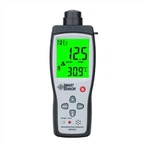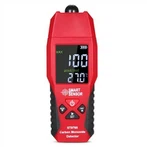What is the error of an infrared thermometer
The infrared thermometer is generally around 0.2.
At present, many infrared thermometers sold on the market are modified from industrial thermometers to prevent SARS. Due to the significant impact of the ambient temperature at that time, there is an error between the measured body temperature and the actual temperature.
Factors affecting the error of infrared thermometer
1. Emissivity
Radiance is a physical quantity that determines the relative radiation ability of an object relative to a blackbody. It is not only related to the material shape, surface roughness, unevenness, etc. of the object, but also to the direction of the test. When an object has a smooth surface, its directionality is more sensitive. The radiation rate of different substances varies, and the amount of radiation energy received by an infrared thermometer from an object is directly proportional to its radiation rate.
(1) The setting of emissivity is based on Kirchhoff's theorem: the hemispherical monochromatic emissivity of an object's surface( ε) Equals its hemispherical monochromatic absorption rate( α),ε=α。 Under thermal equilibrium conditions, the radiation power of an object is equal to its absorption power, i.e. the absorption rate( α)、 Reflectivity( ρ)、 Transmittance( γ) The total is 1, i.e α+ρ+γ= 1. Visible transmittance for objects that are opaque (or have a certain thickness) γ= 0, only radiation and reflection( α+ρ= 1) When the emissivity of an object is higher, the reflectivity is smaller, and the influence of background and reflection is smaller, the accuracy of the test is also higher; On the contrary, the higher the background temperature or reflectivity, the greater the impact on the test. From this, it can be seen that in the actual detection process, attention must be paid to the corresponding emissivity of different objects and thermometers, and the setting of emissivity should be as accurate as possible to reduce the error of the measured temperature.
(2) Test angle
The emissivity is related to the testing direction, and the larger the testing angle, the greater the testing error. This is easily overlooked when using infrared for temperature measurement. Generally speaking, the testing angle should be within 30 ° C and should not be greater than 45 ° C. If it is necessary to test at a temperature greater than 45 ° C, the emissivity can be adjusted appropriately for correction. If the temperature measurement data of two identical objects needs to be judged and analyzed, the testing angle must be the same during testing, in order to be more comparable.
2. Distance coefficient
The distance coefficient (K=S: D) is the ratio of the distance S from the thermometer to the target and the diameter D of the temperature measurement target. It has a significant impact on the accuracy of the infrared thermometer. The larger the K value, the higher the resolution. Therefore, if the thermometer must be installed away from the target due to environmental conditions, and to measure small targets, a high optical resolution thermometer should be selected to reduce measurement errors. In practical use, many people overlook the optical resolution of thermometers. Regardless of the diameter D of the measured target point, turn on the laser beam and aim it at the measurement target for testing. In fact, they ignored the requirement for the S: D value of the thermometer, which would result in a certain error in the measured temperature.
3. Target size
The accuracy of instrument measurement is determined by the measured object and the field of view of the thermometer. When using an infrared thermometer for temperature measurement, generally only the average value of the determined area on the surface of the measured target can be measured. There are three general situations during testing:






